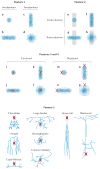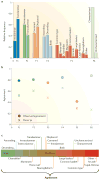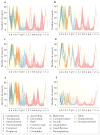New insights into the classification and nomenclature of cortical GABAergic interneurons
- PMID: 23385869
- PMCID: PMC3619199
- DOI: 10.1038/nrn3444
New insights into the classification and nomenclature of cortical GABAergic interneurons
Abstract
A systematic classification and accepted nomenclature of neuron types is much needed but is currently lacking. This article describes a possible taxonomical solution for classifying GABAergic interneurons of the cerebral cortex based on a novel, web-based interactive system that allows experts to classify neurons with pre-determined criteria. Using Bayesian analysis and clustering algorithms on the resulting data, we investigated the suitability of several anatomical terms and neuron names for cortical GABAergic interneurons. Moreover, we show that supervised classification models could automatically categorize interneurons in agreement with experts' assignments. These results demonstrate a practical and objective approach to the naming, characterization and classification of neurons based on community consensus.
Conflict of interest statement
The authors declare no competing financial interests.
Figures






References
-
- Petilla Interneuron Nomenclature Group. Petilla Terminology: nomenclature of features of GABAergic interneurons of the cerebral cortex. Nature Rev Neurosci. 2008;9:557–568. A representative group of researchers proposed a standardized nomenclature of interneuron properties, the Petilla terminology, which has been used as a recognized reference in the recent literature. - PMC - PubMed
-
- Jackson JH. On classification and on methods of investigation (1874) In: Taylor E, editor. Selected Writings. Hodder and Stoughton; 1931.
-
- Hamilton D, Shepherd GM, Martone ME, Ascoli GA. An ontological approach to describing neurons and their relationships. Front Neuroinform. 2012;6(15) This article provides a clear introduction to the neuroinformatics infrastructure requirements of neuronal classification, with a review of the outstanding technical, scientific and social challenges for the field. - PMC - PubMed
-
- von Kölliker A. Handbuch der Gewebelehre des Menschen. Engelmann; German: 1852.
Publication types
MeSH terms
Substances
Grants and funding
LinkOut - more resources
Full Text Sources
Other Literature Sources

